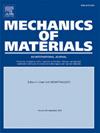材料挤压和随后退火过程中热塑性塑料中结晶诱导的残余变形演变
IF 3.4
3区 材料科学
Q2 MATERIALS SCIENCE, MULTIDISCIPLINARY
引用次数: 0
摘要
材料挤压(MEX)中的热力学历史和随后的高温服务强烈影响半结晶热塑性结构的几何精度。在MEX制造过程中产生的结晶引起的残余应力在随后的中等温度退火过程中部分释放。然而,高温退火引起进一步的冷结晶和额外的残余变形。因此,后续退火过程中残余应力的释放和产生会影响到MEX制造的结构件的高温性能。跟踪制造过程中的结晶历史和随后的退火过程在MEX制造的组件的整个生命周期的设计和评估中起着关键作用。为了解决这一问题,我们开发了一种基于有限元法的单元激活技术和热塑性结晶连续相演化本构模型的MEX过程模拟方法。在仿真过程中,按照实际制造路径依次激活目标物体的各元素,并逐步更新热力学边界条件。在本构模型中,晶体生长是通过一系列连续形成的晶相来模拟的,这些晶相依次添加到初始非晶介质中,以记忆结晶历史以及整个变形历史。因此,在随后的退火过程中,在模拟中观察到结晶诱导的聚乳酸框架结构的双向弯曲,然后通过实验进行验证。在随后的退火过程中,观察到MEX后的方形框架结构首先向下弯曲,最后向上弯曲。最初的向下弯曲是由MEX制造过程中结晶产生的残余应力的释放引起的,最终的向上弯曲是由制造过程中形成的晶体的取向差异和随后的退火引起的。总体而言,较好的一致性表明所开发的方法可以准确地描述制造过程中晶态对后续高温使用性能的继承。本文章由计算机程序翻译,如有差异,请以英文原文为准。

Crystallization-induced residual deformation evolution in thermoplastics during material extrusion and subsequent annealing
Thermomechanical histories in material extrusion (MEX) and subsequent high-temperature service strongly influence the geometric accuracy of semi-crystalline thermoplastic structures. The crystallization-induced residual stress generated in MEX manufacturing process is partially released during subsequent annealing at moderate temperatures. However, high-temperature annealing induces further cold crystallization and additional residual deformation. Therefore, releasing and generating of residual stress in subsequent annealing would affect the high-temperature performance of structural components made by MEX. Tracing the crystallization history during manufacturing and subsequent annealing plays a key role in design and evaluation of components made by MEX throughout the entire lifecycle. To address this issue, we developed a process simulation method for MEX based on the element activation technology of the finite element method and a continuous phase evolution constitutive model of thermoplastic crystallization. In the simulation, the elements of the target object are sequentially activated following the real manufacturing path, and the thermomechanical boundary conditions are updated stepwise. In the constitutive model, crystal growth is modeled by a series of continuously formed crystal phases that are sequentially added to the initial amorphous medium to memorize the crystallization history coupled with the entire deformation history. Therefore, during subsequent annealing, the crystallization-induced bi-directional bending of the polylactic acid frame structure is observed in the simulation, and then verified by experiments. The square frame structure after MEX is observed first to bend downward and finally to bend upward during subsequent annealing. The initial downward bending is induced by the release of the residual stress generated by crystallization during MEX manufacturing, and the final upward bending is induced by the orientation difference of the crystals formed during manufacturing and subsequent annealing. Overall, the good agreement indicates that the developed method can accurately describe the inheritance of the crystalline state during manufacturing on the subsequent high-temperature service performance.
求助全文
通过发布文献求助,成功后即可免费获取论文全文。
去求助
来源期刊

Mechanics of Materials
工程技术-材料科学:综合
CiteScore
7.60
自引率
5.10%
发文量
243
审稿时长
46 days
期刊介绍:
Mechanics of Materials is a forum for original scientific research on the flow, fracture, and general constitutive behavior of geophysical, geotechnical and technological materials, with balanced coverage of advanced technological and natural materials, with balanced coverage of theoretical, experimental, and field investigations. Of special concern are macroscopic predictions based on microscopic models, identification of microscopic structures from limited overall macroscopic data, experimental and field results that lead to fundamental understanding of the behavior of materials, and coordinated experimental and analytical investigations that culminate in theories with predictive quality.
 求助内容:
求助内容: 应助结果提醒方式:
应助结果提醒方式:


